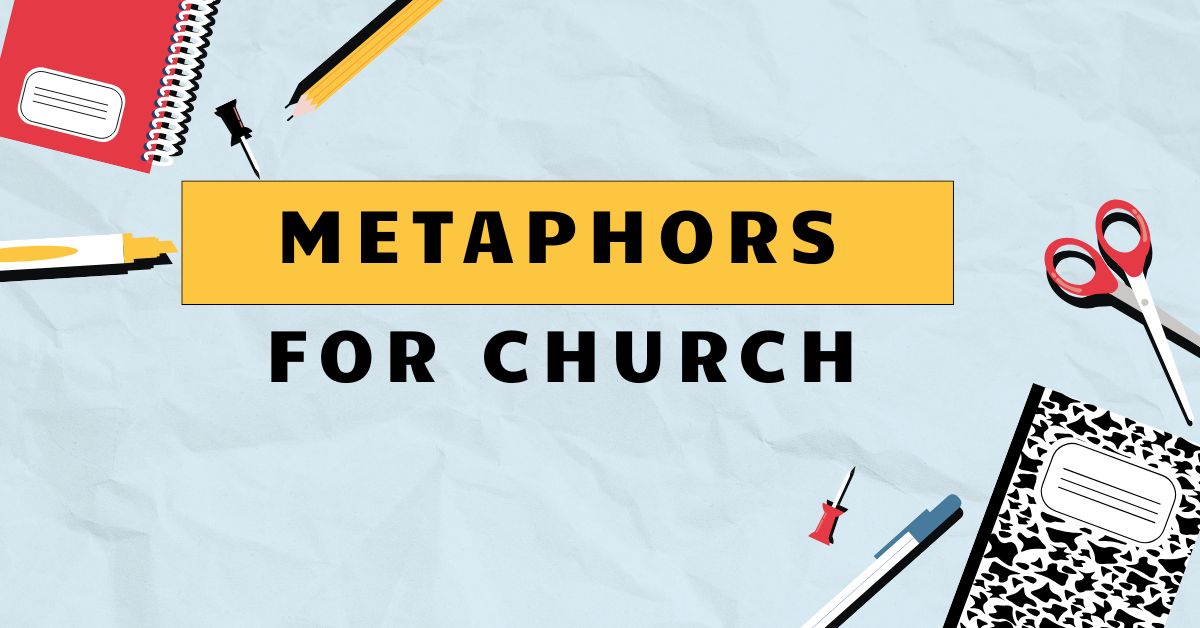39 Metaphors for Church: Understanding Figurative Language
Metaphors are powerful tools in language, allowing us to understand abstract concepts by relating them to more concrete ideas. When discussing the “church,” a concept rich in history, theology, and personal experience, metaphors become particularly important.
Understanding these metaphors enriches our comprehension of the church’s multifaceted nature and its role in the lives of believers. This article explores various metaphors used to describe the church, their significance, and how to interpret them effectively.
This guide is perfect for students of theology, religious studies, and anyone interested in deepening their understanding of the church through the lens of figurative language.
Table of Contents
- Introduction
- Definition of Metaphor and Church
- Structural Breakdown of Metaphors
- Types of Metaphors for Church
- Examples of Metaphors for Church
- Usage Rules and Interpretation
- Common Mistakes in Interpreting Metaphors
- Practice Exercises
- Advanced Topics in Metaphorical Interpretation
- Frequently Asked Questions
- Conclusion
Definition of Metaphor and Church
Ametaphoris a figure of speech that directly compares two unrelated things, asserting that one thingisanother. It’s not a literal comparison, like a simile (which uses “like” or “as”), but rather an implicit comparison that transfers qualities from one concept to another to create a deeper understanding or evoke a particular feeling.
Metaphors add richness and depth to language, allowing us to perceive things in new and insightful ways.
The term “church” (from the Greekekklesia, meaning “assembly” or “called-out ones”) generally refers to a community of believers in Jesus Christ. It can denote a specific local congregation, a denomination, or the universal body of all Christians throughout the world and history.
The church, in its various forms, serves as a place of worship, fellowship, learning, and service, playing a vital role in the spiritual lives of its members.
Structural Breakdown of Metaphors
A metaphor consists of two key elements: thetenorand thevehicle. The tenor is the subject being described (in our case, the church), and the vehicle is the object or concept used to describe the tenor.
The vehicle lends its qualities to the tenor, creating a new understanding of the subject.
For example, in the metaphor “The church is a hospital for sinners,” the tenor is “church,” and the vehicle is “hospital.” The qualities of a hospital—healing, care, and restoration—are transferred to the church, suggesting that the church is a place where people can find healing from their sins.
Understanding the structural components of a metaphor allows us to analyze its meaning and implications more effectively. By identifying the tenor and vehicle, we can explore the connections between them and gain a deeper appreciation for the metaphorical relationship.
Types of Metaphors for Church
The Bible and theological writings employ a variety of metaphors to describe the church, each highlighting different aspects of its nature and function. Let’s explore some of the most prominent metaphors.
The Church as the Body of Christ
This is perhaps the most significant and multifaceted metaphor for the church, found in the writings of Paul (1 Corinthians 12, Romans 12, Ephesians 4). It emphasizes the unity and interdependence of believers.
Each member of the body has a unique role and function, and all are necessary for the body to function properly. Christ is the head of the body, providing direction and life.
This metaphor highlights the importance of diversity within the church, as well as the need for cooperation and mutual support. It also underscores the church’s connection to Christ, its source of life and purpose.
The Church as the Bride of Christ
This metaphor, found in Ephesians 5 and Revelation 19, depicts the intimate and loving relationship between Christ and the church. It emphasizes Christ’s sacrificial love for the church and the church’s devotion to Christ.
The imagery of a bride and groom evokes feelings of anticipation, purity, and commitment.
This metaphor stresses the church’s role as the beloved of Christ, destined for a glorious future with him. It also calls the church to maintain its purity and faithfulness in anticipation of Christ’s return.
The Church as the Flock of God
This metaphor, found in John 10 and 1 Peter 5, portrays Christ as the Good Shepherd who cares for and protects his sheep (the church). It emphasizes Christ’s role as the protector and provider of the church, as well as the church’s dependence on him.
The image of a flock suggests a sense of community and belonging.
This metaphor highlights the importance of pastoral care and leadership within the church. It also reminds believers to trust in Christ’s guidance and protection.
The Church as the Family of God
This metaphor, found in Ephesians 2 and 1 Timothy 3, emphasizes the relational aspect of the church. Believers are adopted into God’s family and become brothers and sisters in Christ.
This metaphor highlights the importance of love, support, and mutual care within the church.
This metaphor calls the church to embody the values of a healthy family, such as forgiveness, compassion, and encouragement. It also reminds believers that they are part of something larger than themselves, a community bound together by love.
The Church as the Temple of the Holy Spirit
This metaphor, found in 1 Corinthians 3 and Ephesians 2, depicts the church as the dwelling place of God’s Spirit. It emphasizes the church’s holiness and its role as a place where God’s presence is manifested.
The image of a temple suggests a sense of sacredness and reverence.
This metaphor highlights the importance of spiritual growth and purity within the church. It also reminds believers that they are part of a holy community, set apart for God’s purposes.
The Church as the Vine and Branches
This metaphor, found in John 15, portrays Christ as the vine and believers as the branches. It emphasizes the church’s dependence on Christ for life and fruitfulness.
The image of a vine and branches suggests a close and organic connection.
This metaphor highlights the importance of abiding in Christ and drawing strength from him. It also reminds believers that they are called to bear fruit, demonstrating the love and character of Christ in their lives.
The Church as the City of God
This metaphor, found in Hebrews 12 and Revelation 21, depicts the church as a heavenly city, a place of security, peace, and fellowship with God. It emphasizes the church’s eternal destiny and its role as a beacon of hope in a fallen world.
The image of a city suggests a sense of community and purpose.
This metaphor reminds believers that their ultimate citizenship is in heaven and that they are called to live as citizens of God’s kingdom on earth. It also inspires them to work for justice and peace in the world, reflecting the values of God’s city.
The Church as the Pillar and Foundation of Truth
This metaphor, found in 1 Timothy 3:15, emphasizes the church’s role in upholding and proclaiming the truth of the Gospel. It highlights the church’s responsibility to preserve sound doctrine and to defend the faith against error.
The image of a pillar and foundation suggests strength and stability.
This metaphor reminds believers of the importance of studying and understanding the Scriptures. It also calls the church to be a voice of truth in a world of deception and confusion.
Examples of Metaphors for Church
The following tables provide extensive examples of how these metaphors are used in various contexts. Each table focuses on a specific metaphor and illustrates its application through sentences and brief explanations.
These examples aim to clarify the nuances of each metaphor and how they contribute to understanding the church.
Table 1: Examples of the Church as the Body of Christ
This table illustrates the various ways in which the metaphor of the church as the Body of Christ is used, highlighting themes of unity, interdependence, and the unique roles of individual members.
| Example | Explanation |
|---|---|
| “The church is the body of Christ, and each member is vital to its functioning.” | Emphasizes the importance of every individual within the church community. |
| “When one part of the body suffers, the whole body feels the pain; so it is with the church.” | Highlights the interconnectedness and empathy within the church. |
| “Just as the eye cannot say to the hand, ‘I don’t need you,’ so too in the church, no one is dispensable.” | Illustrates the necessity of each member’s contribution, regardless of perceived importance. |
| “Christ is the head of the body, guiding and directing the church.” | Affirms Christ’s leadership and authority over the church. |
| “We are all members of one body, striving together to fulfill God’s purpose.” | Highlights the collective effort and shared mission of the church. |
| “The church’s diversity is its strength, just as a body needs different organs to function effectively.” | Celebrates the variety of gifts and talents within the church community. |
| “Let us build up the body of Christ, so that it may grow and mature in love.” | Encourages spiritual growth and development within the church. |
| “The church is not just a building; it’s a living, breathing body of believers.” | Emphasizes the dynamic and organic nature of the church. |
| “Each member of the body has a unique gift to offer, contributing to the overall health of the church.” | Highlights the importance of using individual talents for the benefit of the community. |
| “The body of Christ is called to be a light to the world, reflecting God’s love and grace.” | Emphasizes the church’s mission to share the Gospel and serve others. |
| “In the body of Christ, we find healing and wholeness, as we support one another through life’s challenges.” | Highlights the supportive and restorative environment within the church. |
| “As the body of Christ, we are called to unity, despite our differences, reflecting the love of Christ.” | Emphasizes unity despite differences in the church. |
| “The church, as the body of Christ, must act with compassion and justice, reflecting Christ’s heart for the marginalized.” | Highlights social responsibility and justice within the church. |
| “Each cell in the body is essential; likewise, every member in the church has a crucial role to play.” | Reinforces the importance of each individual member. |
| “The body of Christ is strengthened through prayer, worship, and fellowship.” | Highlights key practices that nurture the church. |
| “We are the hands and feet of Christ, reaching out to a world in need.” | Emphasizes active service and outreach. |
| “The church is like a symphony, with each instrument contributing to a beautiful and harmonious sound.” | Illustrates the harmonious collaboration within the church. |
| “As the body of Christ, we are called to bear one another’s burdens and celebrate each other’s joys.” | Highlights mutual support and empathy. |
| “The church is a mosaic, with each individual piece contributing to a beautiful and complete picture.” | Illustrates the diversity and completeness of the church. |
| “By working together as the body of Christ, we can accomplish far more than we could alone.” | Emphasizes the power of collective effort. |
| “The church, as the body of Christ, is called to be a vessel of hope, love, and reconciliation in a broken world.” | Highlights the church’s role as a beacon of hope. |
| “Like the different organs in a body, each ministry within the church serves a unique and vital function.” | Illustrates the importance of various ministries. |
| “The health of the body depends on the nourishment it receives; similarly, the church thrives on God’s Word.” | Emphasizes the importance of spiritual nourishment. |
| “The church is not a building, but a living organism, constantly growing and evolving in faith.” | Highlights the dynamic nature of the church. |
Table 2: Examples of the Church as the Bride of Christ
This table presents examples showcasing the metaphor of the church as the Bride of Christ, emphasizing themes of love, purity, anticipation, and the intimate relationship between Christ and His followers.
| Example | Explanation |
|---|---|
| “The church, as the bride of Christ, eagerly awaits the return of her bridegroom.” | Emphasizes the anticipation and hope for Christ’s second coming. |
| “The church is adorned in righteousness, ready to meet her bridegroom, Jesus Christ.” | Highlights the purity and holiness required of the church. |
| “As the bride of Christ, the church is called to be faithful and devoted to her husband.” | Stresses the importance of loyalty and commitment to Christ. |
| “Christ loved the church and gave himself up for her, just as a bridegroom sacrifices for his bride.” | Reflects Christ’s sacrificial love and devotion to the church. |
| “The church is being prepared as a radiant bride, without stain or wrinkle, holy and blameless.” | Highlights the ongoing process of sanctification and purification within the church. |
| “The wedding feast of the Lamb symbolizes the ultimate union between Christ and his bride, the church.” | Represents the joyous and eternal relationship between Christ and the church. |
| “The church’s love for Christ should be as passionate and unwavering as a bride’s love for her groom.” | Encourages deep and fervent love for Christ. |
| “Like a bride preparing for her wedding day, the church should be diligent in her spiritual preparation.” | Emphasizes the importance of spiritual readiness. |
| “The church is called to reflect the beauty and glory of Christ, just as a bride radiates on her wedding day.” | Highlights the church’s role in reflecting Christ’s character. |
| “The bride of Christ is eagerly awaiting the day when she will be united with her beloved forever.” | Reiterates the hopeful anticipation of eternal union with Christ. |
| “The church, as the bride, is adorned with good works, reflecting the love and grace of Christ.” | Highlights the importance of good deeds and service. |
| “Christ’s love for the church is a model for husbands to love their wives sacrificially.” | Provides a relational model for marital love. |
| “The church is betrothed to Christ, awaiting the fulfillment of their eternal covenant.” | Emphasizes the sacredness and permanence of the relationship. |
| “As the bride of Christ, the church is called to be a beacon of hope and love in a dark world.” | Highlights the church’s role as a source of hope. |
| “The church’s ultimate joy will be found in the presence of her bridegroom, Jesus Christ.” | Points to the ultimate source of joy and fulfillment. |
| “The church is like a garden, carefully tended by the bridegroom, Christ, to produce beautiful fruit.” | Illustrates Christ’s nurturing care for the church. |
| “As the bride of Christ, the church is called to be pure and undefiled, set apart for her beloved.” | Emphasizes the call to holiness and separation. |
| “The church’s faithfulness to Christ is like a bride’s unwavering commitment to her husband.” | Highlights the importance of steadfast commitment. |
| “The church is a tapestry woven with love, loyalty, and devotion to her bridegroom, Jesus Christ.” | Illustrates the intricate and beautiful relationship. |
| “The church, as the bride of Christ, is a reflection of his glory and grace to the world.” | Highlights the church’s role in reflecting Christ’s character. |
| “Every act of service and love within the church is a precious jewel adorning the bride of Christ.” | Illustrates how acts of service beautify the church. |
| “The church eagerly prepares for the day when she will be united with Christ in eternal bliss.” | Reiterates the anticipation of eternal union. |
| “Christ’s love for the church is a never-ending song, sung over his beloved bride.” | Illustrates the enduring nature of Christ’s love. |
| “The church, as the bride of Christ, is a vessel of his love, poured out for the world to see.” | Highlights the church’s role in spreading Christ’s love. |
Table 3: Examples of the Church as the Flock of God
This table offers examples of the church being described as the Flock of God, focusing on themes of guidance, protection, care, and the role of Christ as the Good Shepherd.
| Example | Explanation |
|---|---|
| “The church is the flock of God, and Jesus is the Good Shepherd who leads us.” | Emphasizes Christ’s leadership and guidance over the church. |
| “As the flock of God, we trust in the Shepherd’s care and protection.” | Highlights the trust and dependence of the church on Christ. |
| “The Good Shepherd knows his sheep by name and cares for each one individually.” | Illustrates Christ’s personal care and attention to each believer. |
| “The church is a safe pasture where the flock of God can find nourishment and rest.” | Represents the church as a place of spiritual sustenance and peace. |
| “The Shepherd protects his flock from danger, guiding them away from harm.” | Highlights Christ’s role as protector and guardian of the church. |
| “The church is a community of sheep, following the voice of the Good Shepherd.” | Emphasizes the importance of obedience and following Christ’s teachings. |
| “The Good Shepherd lays down his life for his sheep, demonstrating his ultimate love and sacrifice.” | Reflects Christ’s sacrificial love for the church. |
| “As the flock of God, we are called to stay close to the Shepherd and to one another.” | Encourages unity and fellowship within the church. |
| “The church is a haven for lost sheep, where they can find refuge and restoration.” | Highlights the church as a place of welcome and healing. |
| “The Good Shepherd rejoices when one of his sheep returns to the flock.” | Represents the joy and celebration in heaven when a sinner repents. |
| “The church, as the flock of God, is led by pastors who serve as under-shepherds, caring for the sheep.” | Highlights the role of church leaders in pastoral care. |
| “The Shepherd guides his flock through green pastures and beside still waters, providing for their needs.” | Illustrates Christ’s provision and care for the church. |
| “As the flock of God, we are called to be gentle and compassionate towards one another.” | Emphasizes the importance of kindness and empathy within the church. |
| “The Shepherd’s rod and staff provide comfort and guidance to the flock.” | Represents Christ’s discipline and direction in the lives of believers. |
| “The church is a place where the flock of God can grow in grace and knowledge of the Shepherd.” | Highlights the importance of spiritual growth and learning. |
| “The Good Shepherd searches for the lost sheep until he finds them, demonstrating his relentless love.” | Illustrates Christ’s persistent pursuit of those who are lost. |
| “As the flock of God, we are called to be a witness to the Shepherd’s love and grace in the world.” | Emphasizes the church’s mission to share the Gospel. |
| “The church is a protected community where the flock of God can thrive under the Shepherd’s watchful eye.” | Highlights the security and safety found within the church. |
| “The Shepherd’s voice is a beacon of hope, guiding the flock through dark and uncertain times.” | Represents Christ’s guidance and comfort in times of trouble. |
| “The church, as the flock of God, is a testament to the Shepherd’s unwavering love and care.” | Highlights the enduring nature of Christ’s love for the church. |
| “The Shepherd’s heart is filled with compassion for his flock, leading him to provide for their every need.” | Illustrates Christ’s deep compassion and provision for the church. |
| “As the flock of God, we are called to be faithful followers, trusting in the Shepherd’s wisdom and guidance.” | Emphasizes the importance of faith and trust in Christ’s leadership. |
| “The church is a place where the flock of God can find healing, restoration, and new beginnings.” | Highlights the restorative power of the church community. |
| “The Good Shepherd’s love for his flock is a boundless and eternal gift, offered to all who believe.” | Represents the limitless and everlasting nature of Christ’s love. |
Usage Rules and Interpretation
Interpreting metaphors requires careful consideration of context and cultural background. It’s important to understand the qualities of the vehicle and how they relate to the tenor.
Avoid literal interpretations, and instead, focus on the underlying meaning and the intended message. Consider the historical and literary context in which the metaphor is used.
For example, when interpreting the church as the “Body of Christ,” we must understand the concept of a body and its interconnected parts. Each part has a unique function, and all are necessary for the body to function properly.
Applying this understanding to the church, we can see that each member has a unique role and that all are needed for the church to thrive.
Common Mistakes in Interpreting Metaphors
One common mistake is to take metaphors too literally. For example, interpreting the church as the “Bride of Christ” does not mean that the church is literally a woman marrying Jesus.
Instead, it symbolizes the deep love and commitment between Christ and the church.
Another mistake is to ignore the cultural context of the metaphor. For example, understanding the role of a shepherd in ancient Israel helps us to better understand the metaphor of the church as the “Flock of God.”
Here are some examples of incorrect and correct interpretations:
| Metaphor | Incorrect Interpretation | Correct Interpretation |
|---|---|---|
| Church as the Body of Christ | Each person in the church is a literal body part. | Each member has a unique and necessary role, contributing to the whole. |
| Church as the Bride of Christ | The church is a literal woman marrying Jesus. | The church shares a deep, loving, and committed relationship with Christ. |
| Church as the Flock of God | Church members are actual sheep. | Christians are under the care and guidance of Jesus, their Shepherd. |
Practice Exercises
Test your understanding of metaphors for the church with these exercises. Identify the metaphor used in each sentence and explain its meaning.
Exercise 1: Identifying Metaphors
In this exercise, identify the metaphor used in each sentence and explain its significance in understanding the church.
| Question | Answer |
|---|---|
| 1. The church is a lighthouse, guiding people to safety amidst the storms of life. | Metaphor: Lighthouse. Meaning: The church provides guidance and hope in difficult times. |
| 2. The church is a tapestry, woven together with diverse threads of culture and experience. | Metaphor: Tapestry. Meaning: The church is a unified whole made up of diverse individuals. |
| 3. The church is a garden, where seeds of faith are planted and nurtured. | Metaphor: Garden. Meaning: The church is a place where faith grows and flourishes. |
| 4. The church is a bridge, connecting people to God and to one another. | Metaphor: Bridge. Meaning: The church facilitates relationships between people and God. |
| 5. The church is a symphony, where different voices blend together in harmonious worship. | Metaphor: Symphony. Meaning: The church is a community where diverse talents come together in unity. |
| 6. The church is a school, where believers learn and grow in their understanding of God. | Metaphor: School. Meaning: The church is a place of learning and spiritual development. |
| 7. The church is a hospital, where the wounded find healing and restoration. | Metaphor: Hospital. Meaning: The church is a place of healing and recovery from spiritual and emotional wounds. |
| 8. The church is a family, where members support and care for one another. | Metaphor: Family. Meaning: The church is a community of love, support, and belonging. |
| 9. The church is a fortress, providing protection from the attacks of the enemy. | Metaphor: Fortress. Meaning: The church offers security and defense against spiritual threats. |
| 10. The church is a river, flowing with the living water of the Holy Spirit. | Metaphor: River. Meaning: The church is a source of spiritual life and refreshment. |
Exercise 2: Interpreting Metaphors
In this exercise, explain the meaning and implications of each metaphor for the church in a short paragraph.
| Question | Answer |
|---|---|
| 1. Explain the meaning of the church as “salt and light.” | The metaphor “salt and light” signifies that the church is meant to preserve and illuminate the world. Salt preserves from decay, indicating that the church should uphold moral standards and resist corruption. Light illuminates, suggesting that the church should spread the Gospel and reveal God’s truth to others. Together, these metaphors emphasize the church’s responsibility to positively influence society and guide people towards God. |
| 2. Explain the meaning of the church as a “spiritual house.” | The metaphor “spiritual house” implies that the church is a dwelling place for God and a community of believers who are being built together into a holy temple. It suggests that the church is not just a physical building but a living, growing structure made up of individuals who are connected to Christ, the cornerstone. Each member contributes to the overall strength and stability of the house, creating a place where God’s presence is manifested and people can encounter Him. |
| 3. Explain the meaning of the church as an “army.” | The metaphor “army” depicts the church as a fighting force engaged in spiritual warfare against evil. It suggests that believers are soldiers who must be disciplined, courageous, and equipped to defend the faith and advance God’s kingdom. The church is not passive but actively involved in battling against spiritual forces of darkness, proclaiming truth, and standing for righteousness. This metaphor emphasizes the need for unity, strategy, and perseverance in the face of opposition. |
| 4. Explain the meaning of the church as a “field of crops.” | The metaphor “field of crops” portrays the church as a place of growth, cultivation, and harvest. It suggests that believers are like seeds planted in fertile soil, nurtured by God’s Word and the Holy Spirit to produce abundant fruit. The church is responsible for tending to the field, weeding out sin, and providing the necessary resources for growth. The ultimate goal is to yield a bountiful harvest of new believers and mature disciples who will impact the world for Christ. |
| 5. Explain the meaning of the church as a “ship.” | The metaphor “ship” represents the church as a vessel navigating through the seas of life, guided by Christ as the captain. It suggests that believers are passengers who must work together to weather storms, maintain course, and reach their destination. The church is responsible for ensuring the safety and well-being of its members, providing direction, and navigating through the challenges of the world. This metaphor emphasizes the importance of teamwork, leadership, and reliance on God’s guidance. |
| 6. Explain the meaning of the church as a “candle.” | The metaphor “candle” depicts the church as a source of light in a dark world, illuminating the path to God and truth. It suggests that believers are called to shine brightly, reflecting the love, grace, and hope of Christ to others. The church is responsible for maintaining its flame, fueled by prayer, worship, and obedience to God’s Word. This metaphor emphasizes the importance of visibility, authenticity, and spreading the light of the Gospel to those who are lost. |
| 7. Explain the meaning of the church as a “well.” | The metaphor “well” represents the church as a source of living water, providing spiritual nourishment and refreshment to those who are thirsty. It suggests that believers can draw from the well of God’s grace, love, and truth to satisfy their deepest needs. The church is responsible for maintaining the purity and accessibility of the well, ensuring that all who come can drink freely and be renewed. This metaphor emphasizes the importance of provision, sustenance, and meeting the spiritual needs of others. |
| 8. Explain the meaning of the church as a “school of prophets.” | The metaphor “school of prophets” portrays the church as a place where believers are equipped to hear God’s voice, understand His will, and speak His truth to the world. It suggests that the church is responsible for training and developing prophetic gifts, fostering an environment of discernment, and empowering individuals to declare God’s message with boldness and accuracy. This metaphor emphasizes the importance of spiritual sensitivity, prophetic ministry, and speaking truth to power. |
| 9. Explain the meaning of the church as a “city on a hill.” | The metaphor “city on a hill” depicts the church as a visible and influential community, set apart to demonstrate God’s kingdom to the world. It suggests that believers are called to live exemplary lives, reflecting God’s values and attracting others to Christ. The church is responsible for maintaining its integrity, upholding justice, and serving as a beacon of hope and righteousness. This metaphor emphasizes the importance of visibility, influence, and living a life that glorifies God. |
| 10. Explain the meaning of the church as a “mirror.” | The metaphor “mirror” represents the church as a reflection of God’s character and glory. It suggests that believers are called to reflect Christ’s image
, displaying His love, grace, and truth to the world. The church is responsible for maintaining a clear and accurate reflection, allowing others to see God’s attributes through their lives. This metaphor emphasizes the importance of authenticity, transparency, and reflecting the nature of God. |
Advanced Topics in Metaphorical Interpretation
Delving deeper into metaphorical interpretation involves understanding the nuances of cultural contexts, historical backgrounds, and the original languages in which these metaphors were first expressed. It requires a nuanced understanding of hermeneutics, the study of interpretation, to avoid imposing modern meanings onto ancient texts.
For instance, understanding the agricultural practices of first-century Palestine can provide richer insights into the “vine and branches” metaphor. Similarly, knowing the social dynamics of family life in biblical times can deepen our comprehension of the “family of God” metaphor.
Advanced study also involves comparing different metaphors to see how they complement or challenge one another, providing a more comprehensive understanding of the church.
Frequently Asked Questions
Conclusion
Metaphors for the church provide a rich and multifaceted understanding of its nature and function. By exploring these metaphors, we gain a deeper appreciation for the church’s unity, diversity, purpose, and mission.
As we continue to study and reflect on these metaphors, may we be inspired to live out our faith more fully and to contribute to the flourishing of the church in the world.







